Conveying
Conveyors: Keeping Them Clean and Running
Give conveyor systems the attention they deserve and they’ll keep moving your product from process toward shipping.
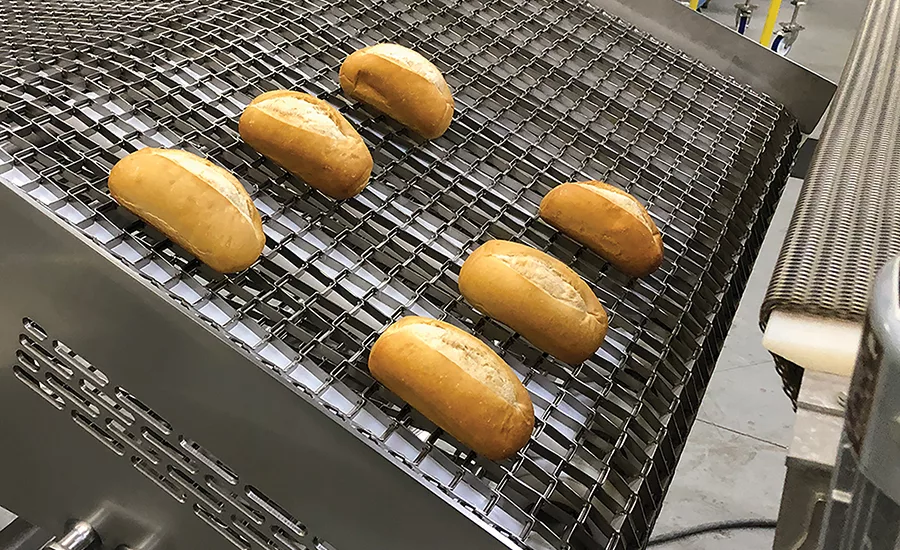
This pivoting wire mesh bakery conveyor features a welded design, bearing caps, sanitary removable finger guards on the shafts, clean-out holes and open mesh top for complete wash down capability by Multi-Conveyor. Image courtesy of Multi-Conveyor
While automation has been a boon when applied to material movement, nevertheless, according to a recent study from Quality Digest, food plant engineers say that keeping conveyors clean can eat up precious production time, while maintenance accounts for too much downtime. This article looks at steps conveyor companies have been taking to make cleaning faster and keep maintenance time at a minimum.
Making Manual Cleaning Easier
Manual cleaning will always be necessary for some conveyors and applications—you just can’t get away from it. So, making equipment selections based on the right criteria is important. “The first step to consider when it comes to cleaning is in the design of the equipment,” says Barry Whitman, director of business development, Grote Company, PFI and Vanmark. “We design and build equipment so those ‘tough areas’ are accessible, and all parts are easily removed for effective and efficient deep cleaning. For example, where water can’t be used to clean, we build bucket elevators that make it easy for buckets to be removed, put on a cart, washed in a different room, then brought back and reinstalled.”
The materials used can also make a difference, adds Whitman. “High grades of plastics and stainless steel are important. Also, we take great care to design our equipment for ease of manufacturing (less welding needed, more open area, easily form fitted, etc.).”
The best food-grade conveyor equipment is made from high-quality, hygienic materials, says Whitman. To minimize the risk of contamination, any surface that comes into contact with food must be:
- Smooth and free of cracks, crevices or dents
- Nonporous and nonabsorbent
- Non-reactive to food products
- Corrosion resistant
- Requiring little or no maintenance to maintain these characteristics
To ensure hygiene, most leading brand manufacturers of sanitary conveyors choose either FDA-approved food-grade plastics for belting or bucket systems and a range of metals for contact surfaces, depending on the application.
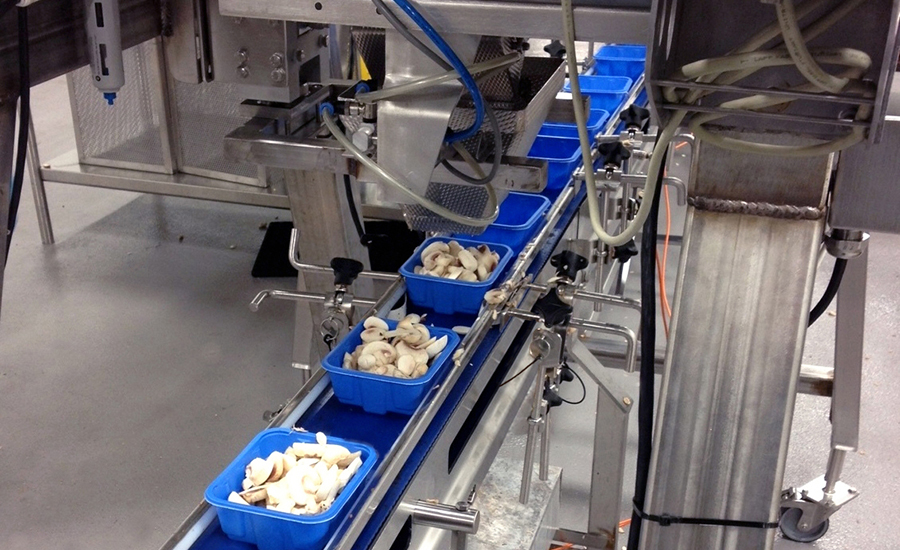
However, most conveyor companies are doing their best to make the cleaning process easier and faster. Over the years, suppliers like Dorner have reduced the number of tools required to disassemble a conveyor for cleaning and now have machines requiring no tools for teardown.
Dorner’s tip-up tail belt tensioning system offers an easy way to prep the conveyor system for cleaning in less than one minute and can be disassembled entirely in three minutes, says Director of Marketing Lindsey Muchka. With no need for tools, the optional belt lifter allows the conveyor tail to be tipped up, releasing the belt tension and allowing operators to clean the underside of the belt and the entire conveyor frame.
In addition, Dorner’s engineers designed its AquaPruf conveyor systems with as little flat surface area as possible to reduce debris buildup and provide fast cleaning during line changeover. With frame cutouts and easily removable belt support or bed plates, conveyors can be effectively disassembled, cleaned and sanitized, then reassembled quickly and without the need for tools, says Muchka.
“Internal and external shelves and ledges formed by structural members are now angled to prevent accumulation of dust and debris, thus making cleaning of those areas much easier,” says Joe Miller, Multi-Conveyor COO. Having a keen understanding of effective CIP (clean-in-place) washdown design is also key. Stainless steel, washdown-constructed conveyors are built to withstand raw and processed food production.
Miller suggests that following the manufacturer’s recommended equipment maintenance will improve the operation, reliability and longevity of the system. Another suggestion: Have the conveyor manufacturer perform control verification(s) in the target plant to “fine-tune” the conveyor to a particular line. “Be aware of toolless belt removal and NTR (no tools required) options for minimal belt cleaning maintenance in specific washdown environments,” adds Miller. Why? “Some access covers have been designed to require tools to remove; this prevents untrained operators (without tools) from getting into dangerous areas of the machine.”
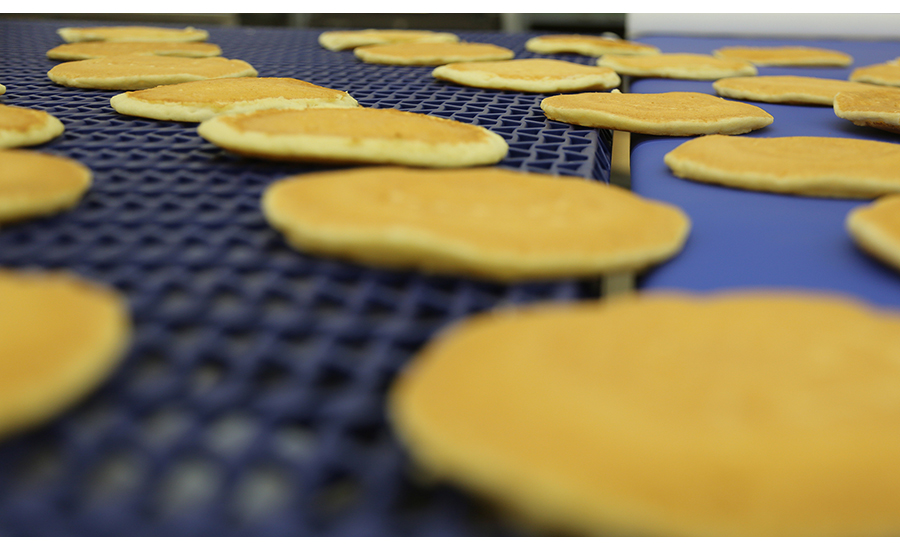
“We have a full suite of cleaning components specifically designed for Cablevey Conveyors to make the cleaning process easier, quicker and more reliable,” says John Adair. director of engineering. “These components range from as simple as our multifunctional cleaning disc, to which you can attach a wiper, brush or sponge, to our top-of-the-line clean-in-place ‘Cleanvey’ cart and spray ball options.”
“Our Ever-Kleen design methodology dictates how our equipment is designed, fabricated and installed for sanitary applications,” says Kory Graham, Tri-Mach Inc. senior director of sales. “Ever-Kleen is the difference between your equipment being sanitary for a moment and being sanitary for its lifetime. It’s not about cleanliness, it’s about how it is designed to be clean and stay clean.”
“Our conveyors have a tool-less design that allows for easy access to all parts for cleaning and inspection. They also have a sloped design that prevents water and product accumulation and facilitates drainage. All components are stood off the frame, eliminating harborage points and welded instead of bolted.” adds Graham.
Most conveyor manufacturers have facilities for testing conveyor applications before being shipped to a processor’s facility. And they will test with actual product so you will know in advance what to expect.
All new Cablevey products are tested extensively at one of our technology center locations and we enthusiastically encourage all customers to come out and participate in the process, says Adair. During the testing process, we are looking at the ability to convey the product while also focusing on cleaning and maintenance of the conveyor for the specific product. If the customer cannot physically attend the test, we also offer video conference options during the test and always provide a detailed report following testing.
According to Muchka, “Dorner works with manufacturers to produce accurate simulations of the end solution that a product will be manufactured in. We take in products from our applications and run the exact product through rigorous testing to ensure that our conveyors can meet the end users’ expectations by capturing it with video by our sales applications team.”
“PFI can simulate what a customer needs to do on our shop floor,” says Whitman. “Sometimes the customer sends us product to test for them, or we can buy it in the store and test it that way. Such tests usually provide a good idea of what will happen when equipment is installed in their environment.”
Since everything is custom made to order, our testing program primarily occurs prior to shipping to the customer, says Tri-Mach’s Graham. “We have a walk-in cooler and a freezer within our facility to test product integrity, as well as transfer testing to ensure smooth and gentle handling of the products. We also show examples of past projects that are similar to the customer’s needs to demonstrate our capabilities and experience. Furthermore, we run simulation testing to ensure that the product meets or exceeds the customers’ requirements before anything tangible is created.”
Multi-Conveyor has a designated Test Center on the production floor used to pre-test customer samples prior to the quotation process. More important, however, is the ability to adapt unforeseen equipment changes during mid-stream production or post-FAT. Factory Acceptance Tests (FAT) are done at Multi-Conveyor’s plant, says Miller. “We encourage full equipment approval, in action, ensuring optimum performance well before we dismantle and prepare for shipment. In some cases, after coming to a FAT, a customer may decide to tweak their conveyor or conveying device. This is generally due to their own line changes that came later in the project, or may be based on what they have seen at the FAT that they choose to adjust from their original order, requesting a design change prior to shipment. It takes custom conveyor manufacturing with an in-house team of team of designers, engineers and electrical wizards to pull off equipment changes on the fly. Audits can also be performed at a customer location to evaluate proposed conveyor design maximum conveyor footprint parameters.”
Special Issues in Conveying Dry Materials
While pneumatic and vacuum conveyors have their advantages for moving dry powders and such, they do have their own set of potential cleaning and maintenance problems. “The most common failure mode of pneumatic and vacuum conveyance systems is due to plugging of product within the system,” says Zac Ulmer, senior process engineer at Gray Solutions, a CSIA (Control System Integrators Association) certified member. This commonly occurs at directional changes and the bottom of vertical routing.
Therefore, maintaining the reliability of these systems will go hand in hand with keeping the system clean and sanitary. To do this, the design must consider the reduction of piping elbows within the pneumatic route. When this is unavoidable, a sweeping, wide-arc design can be used to reduce buildup; however, plant maintenance should expect this type of design to become a wear point. “Typically, we recommend placing these sweeping elbows in areas that are accessible with flanged connections that can be easily removed,” adds Ulmer. “In addition, ensure additional pipe support is considered at this location to reduce pipe strain as a safety measure for those who will be handling this piping after installation.” If a large vertical run is necessary, install removable piping sections and clean-out access at the bottom of the vertical run. Consider longer run time on the blower controls after product has ceased being fed into the system to allow material to clear out before settling in the low points in the system, says Ulmer.
Also used for dry products, bucket elevators will convey organic materials within a food production facility; therefore, it is within NFPA (National Fire Protection Association) code to maintain adequate aspiration on these units to prevent hazards due to dust, adds Ulmer. Properly aspirating dust from a system and containing dust properly once it is recovered is both a safety requirement and an ideal sanitation control measure. “Dust will collect in the most difficult-to-reach areas of your facility just like it does within your home, so removing it as a source in the first place is the best method of control. This same design philosophy should be used at any point in the system where dry product can be moved at a rapid speed or outside of closed containment,” says Ulmer.
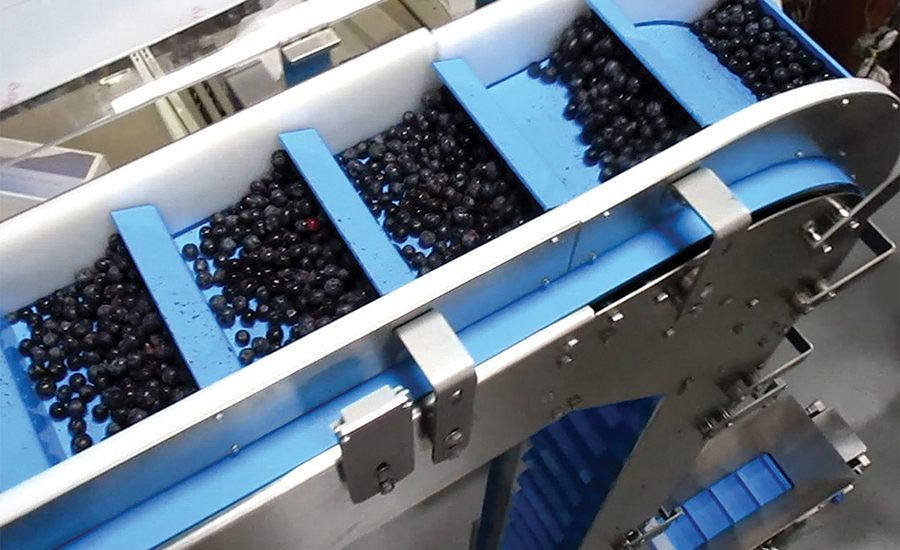
CIP for Conveyors: Ready to GO or Custom Designs
If you can employ CIP effectively in an application, you can save time in cleaning and, in theory, should be able to verify and validate the cleaning process more expediently than a manual process. Most conveyor vendors offer “CIPable” designs ready to go, but in many cases your own needs may dictate custom designs, which conveyor suppliers can handle with a little input on the application. For example, Dorner offers an optional clean-in-place solution for the AquaPruf and AquaPruf Ultimate conveyors.
“We have offered a wet-clean, CIPable conveyor system for a while now: our 300 series,” says Cablevey’s Adair. “Then, just in the last two years, we have gone a step further to provide our own Cablevey tailored CIP cart and sprayball options. Our goal was to offer our customers a complete turnkey solution for the cleaning of their Cablevey systems.”
Multi-Conveyor has its own experienced in-house engineers that understand the need for effective, easy-to-clean, CIP/COP and washdown equipment, says Miller. Conveyors used in food processing plants may specify clean-out ports, spray nozzles, belt lifts, easily removable carry-and-return-way components. Sanitary features should include standoffs for frame mounted elements, sanitary supports and washdown-rated power transmission components. “Discussing agency (FDA, USDA, 3A, BISSC, etc.) regulated food safety requirements before you have a conveyor built should alleviate post-installation regulatory issues,” says Miller.
PFI often gets preferred CIP information from the customer, then designs its equipment and layout accordingly, says Whitman. “PFI also installs strategically placed spray bars to help with cleaning. We could mount them on bucket elevators and belt conveyors, for example. In these examples, the buckets and belts pass through the CIP system to help in the cleaning process.”
In certain cases, conveyor manufacturers choose not to reinvent the wheel and will go to CIP specialists. “Sometimes, we’ll buy the CIP system and mount it on the conveyor for the customer,” says Whitman. “It’s really about whatever best suits the customer’s needs.”
“We design and fabricate equipment that is capable of integration into a CIP system, as well as create designs for system integrators to build out a CIP system for a specific conveyor as required” says Tri-Mach’s Graham. As always, all CIP equipment is designed and fabricated in-house, allowing the creation of new innovative cleaning solutions.
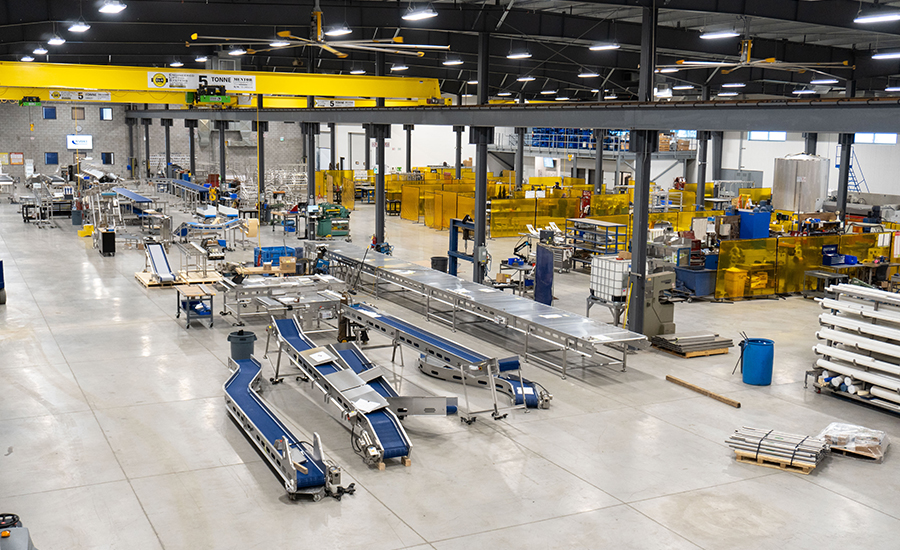
Making Troubleshooting Easier
Along with CIP, predictive maintenance is another area where Cablevey sees a lot of potential to expand and make the everyday maintenance person’s job easier, says Adair. “Although we currently do not offer a predictive maintenance system, it is in the works. In the meantime, we’ve made every effort to make troubleshooting as easy as possible though the use of operation/part manuals, a knowledgeable service staff and quick-to-respond customer service agents.”
PFI helps manufacturers troubleshoot issues that may arise, says Whitman. “We also help them prepare. If you’re working with us on lifecycle health assessments, we could assess the state of the equipment and possibly predict parts that may be close to needing replaced. Based on what’s designed to move for speeds and loads, we can provide an expectation of spring life [for vibratory conveyors] and how often the equipment should be recalibrated.”
PFI recommends following the maintenance schedules and best practices in its manuals and also offers videos that can help. Last, PFI can conduct product testing using equipment in stock and can conduct simulations on behalf of customers. “Based on our decades of experience, we can predict how a piece of equipment may fare over time,” says Whitman.
Don’t Forget PM—and Keep it Safe!
Preventative maintenance (PM) programs are very cost effective, ensuring that all conveyors’ components are maintained for long life and safety, says Multi-Conveyor’s Miller. Recordkeeping and setting up a calendar of maintenance for each machine can be combined into a comprehensive program that reduces accidents and breakdowns. Maintenance safety training should be a required element for anyone expected to perform conveyor maintenance. This helps prevent accidents, lost time and downtime.
Even simple maintenance such as lubrication and adjustments should only be performed by qualified and trained personnel, says Miller. They need to know what to check and how to service the conveyor in a safe manner. As described earlier, some access covers have been designed to require tools to remove; this prevents untrained operators (without tools) from getting into dangerous areas of the machine.
There must be a safe amount of room for maintenance. In-floor pits must allow removal of covers and shafts, and be well lit. Access to conveyor sections above head height must be steady work surfaces with readily available access to controls.
Cleanliness has been seen to be very important both around the operator and inside the machines. Material carryback inside the conveyor can quickly damage costly components and adversely affect conveyor operation. Keep material buildup to a minimum. Inspect regularly inside the unit.
Part of any good maintenance system is a spare parts inventory and system. “We have a three-level system for spare parts to recommend which parts should be stocked,” says Tri-Mach’s Graham. “We encourage customers to stock standard parts that are prone to wear or risk and provide fast and reliable delivery of other parts as needed.
“Furthermore, we utilize similar custom parts across our systems for interchangeability, which reduces the inventory and complexity of spare parts management,” Graham continues. “We limit the number of components as much as possible, which simplifies the design and maintenance of the conveyors. We also conduct detailed simulations of failure points before any project is fabricated, which helps to identify and prevent potential problems before they occur.”
Looking for a reprint of this article?
From high-res PDFs to custom plaques, order your copy today!







